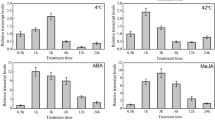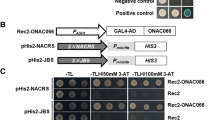Abstract
Key message
SQUAMOSA promoter-binding protein-like 7 mediates copper deficiency response in the presence of high nitrogen even with the sufficient level of copper in Arabidopsis thaliana.
Abstract
Under copper (Cu) deficiency, accumulation of mRNA encoding two Cu/Zn superoxide dismutases, CSD1 and CSD2, is downregulated to save Cu for plastocyanin. This downregulation depends on miR398 and is under the control of SQUAMOSA promoter-binding protein-like7 (SPL7). Arabidopsis seedlings are routinely cultured on Murashige and Skoog medium. However, the high nitrogen (N) content of the medium (60 mM) has been shown to induce a similar response to Cu deficiency. The mRNA and protein levels of CSD1 and CSD2 are reduced under high N conditions, even if the Cu concentration in the medium is sufficient (0.1–0.5 µM). In this study, we show that this symptom, similar to the Cu deficiency, occurred in the presence of high N largely depending on SPL7, suggesting that plants actually sensed Cu deficiency. However, a change in N concentration in the medium did not influence the total Cu concentration in shoots or roots. High N did not increase the protein content in leaves but facilitated rapid seedling growth. We speculate that this rapid growth causes a continuous Cu deficiency mainly because of high Cu uptake by mesophyll cells in the leaves. This idea was supported by the observation that plastocyanin did not overaccumulate at the range of 0.1–0.5 µM Cu with 30 mM N. In contrast, in the presence of 5 µM Cu with 30 mM N, plants accumulate more Cu in plastocyanin in the thylakoid lumen, resulting in a slight Cu deficiency in the chloroplast stroma. This process is independent of SPL7.








Similar content being viewed by others
Abbreviations
- CRR1:
-
Copper response regulator 1
- Cyt:
-
Cytochrome
- MS:
-
Murashige and Skoog
- PC:
-
Plastocyanin
- qRT-PCR:
-
Quantitative reverse transcription-polymerase chain reaction
- RT:
-
Room temperature
- SBP:
-
SQUAMOSA promoter-binding protein
- SD:
-
Standard deviation
- SOD:
-
Superoxide dismutase
- SPL7:
-
SQUAMOSA promoter-binding protein-like 7
- WT:
-
Wild-type
References
Abdel-Ghany SE (2009) Contribution of plastocyanin isoforms to photosynthesis and copper homeostasis in Arabidopsis thaliana grown at different copper regimes. Planta 229:767–779
Abdel-Ghany SE, Müller-Moulé P, Niyogi KK, Pilon M, Shikanai T (2005) Two P-type ATPases are required for copper delivery in Arabidopsis thaliana chloroplasts. Plant Cell 17:1233–1251
Araki R, Mermod M, Yamasaki H, Kamiya T, Fujiwara T, Shikanai T (2018) SPL7 locally regulates copper-homeostasis-related genes in Arabidopsis. J Plant Physiol 224–225:137–143
Arnon DI (1949) Copper enzymes in isolated chloroplasts. Polyphenoloxidase in Beta vulgaris. Plant Physiol 24:1–15
Bernal M, Casero D, Singh V, Wilson GT, Grande A, Yang H et al (2012) Transcriptome sequencing identifies SPL7-regulated copper acquisition genes FRO4/FRO5 and the copper dependence of iron homeostasis in Arabidopsis. Plant Cell 24:738–761
Burkhead JL, Gogolin Reynolds KA, Abdel-Ghany SE, Cohu CM, Pilon M (2009) Copper homeostasis. New Phytol 182:799–816
Czechowski T, Stitt M, Altmann T, Udvardi MK, Scheible W-R (2005) Genome-wide identification and testing of superior reference genes for transcript normalization in Arabidopsis. Plant Physiol 139:5–17
Dugas DV, Bartel B (2008) Sucrose induction of Arabidopsis miR398 represses two Cu/Zn superoxide dismutases. Plant Mol Biol 67:403–417
Garcia-Molina A, Andrés-Colás N, Perea-García A, Neumann U, Dodani SC, Huijser P et al (2013) The Arabidopsis COPT6 transport protein functions in copper distribution under copper-deficient conditions. Plant Cell Physiol 54:1378–1390
Garcia-Molina A, Xing S, Huijser P (2014) Functional characterisation of Arabidopsis SPL7 conserved protein domains suggests novel regulatory mechanisms in the Cu deficiency response. BMC Plant Biol 14:231
Guan Q, Lu X, Zeng H, Zhang Y, Zhu J (2013) Heat stress induction of miR398 triggers a regulatory loop that is critical for thermotolerance in Arabidopsis. Plant J 74:840–851
Hippler FWR, Mattos D Jr, Boaretto RM, Williams LE (2018) Copper excess reduces nitrate uptake by Arabidopsis roots with specific effects on gene expression. J Plant Physiol 228:158–165
Krapp A, Berthomé R, Orsel M, Mercey-Boutet S, Yu A, Castaings L et al (2011) Arabidopsis roots and shoots show distinct temporal adaptation patterns toward nitrogen starvation. Plant Physiol 157:1255–1282
Kropat J, Tottey S, Birkenbihl RP, Depège N, Huijser P, Merchant S (2005) A regulator of nutritional copper signaling in Chlamydomonas is an SBP domain protein that recognizes the GTAC core of copper response element. Proc Natl Acad Sci USA 102:18730–18735
Li H, Hu B, Chu C (2017) Nitrogen use efficiency in crops: lessons from Arabidopsis and rice. J Exp Bot 68:2477–2488
Liang G, He H, Yu D (2012) Identification of nitrogen starvation-responsive microRNAs in Arabidopsis thaliana. PLoS One 7:e48951
Makino A, Sakashita H, Hidema J, Mae T, Ojima K, Osmond B (1992) Distinctive responses of ribulose-1,5-bisphosphate carboxylase and carbonic anhydrase in wheat leaves to nitrogen nutrition and their possible relationships to CO2-transfer resistance. Plant Physiol 100:737–1743
Merchant S, Bogorad L (1986) Rapid degradation of apoplastocyanin in Cu(II)-deficient cells of Chlamydomonas reinhardtii. J Biol Chem 261:15850–15853
Murashige T, Skoog F (1962) A revised medium for rapid growth and bio assays with tobacco tissue cultures. Physiol Plant 15:473–497
Pesaresi P, Scharfenberg M, Weigel M, Granlund I, Schröder WP, Finazzi G et al (2009) Mutants, overexpressors, and interactors of Arabidopsis plastocyanin isoforms: revised roles of plastocyanin in photosynthetic electron flow and thylakoid redox state. Mol Plant 2:236–248
Puig S, Andrés-Colás N, García-Molina A, Peñarrubia L (2007) Copper and iron homeostasis in Arabidopsis: responses to metal deficiencies, interactions and biotechnological applications. Plant, Cell Environ 30:271–290
Ravet K, Pilon M (2013) Copper and iron homeostasis in plants: the challenges of oxidative stress. Antioxid Redox Signal 19:919–932
R Core Team (2018) R: A language and environment for statistical computing. R Foundation for Statistical Computing, Vienna, Austria. https://www.R-project.org/. Accessed 15 Apr 2019
Ren L, Tang G (2012) Identification of sucrose-responsive microRNAs reveals sucrose-regulated copper accumulations in an SPL7-dependent and independent manner in Arabidopsis thaliana. Plant Sci 187:59–68
Sancenón V, Puig S, Mateu-Andrés I, Dorcey E, Thiele DJ, Peñarrubia L (2004) The Arabidopsis copper transporter COPT1 functions in root elongation and pollen development. J Biol Chem 279:15348–15355
Shikanai T, Müller-Moulé P, Munekage Y, Niyogi KK, Pilon M (2003) PAA1, a P-type ATPase of Arabidopsis, functions in copper transport in chloroplasts. Plant Cell 15:1333–1346
Solberg E, Evans L, Penny D (1999) Copper deficiency: diagnosis and correction. http://www1.agric.gov.ab.ca/$department/deptdocs.nsf/all/agdex3476. Accessed 15 Apr 2019
Tapken W, Ravet K, Pilon M (2012) Plastocyanin controls the stabilization of the thylakoid Cu-transporting P-type ATPase PAA2/HMA8 in response to low copper in Arabidopsis. J Biol Chem 287:18544–18550
Tschoep H, Gibon Y, Carillo P, Armengaud P, Szecowka M, Nunes-Nesi A et al (2009) Adjustment of growth and central metabolism to a mild but sustained nitrogen-limitation in Arabidopsis. Plant Cell Environ 32:300–318
Wang CY, Zhang S, Yu Y, Luo YC, Liu Q, Ju C et al (2014) MiR397b regulates both lignin content and seed number in Arabidopsis via modulating a laccase involved in lignin biosynthesis. Plant Biotechnol J 12:1132–1142
Weigel M, Varotto C, Pesaresi P, Finazzi G, Rappaport F, Salamini F et al (2003) Plastocyanin is indispensable for photosynthetic electron flow in Arabidopsis thaliana. J Biol Chem 278:31286–31289
Yamasaki H, Abdel-Ghany SE, Cohu CM, Kobayashi Y, Shikanai T, Pilon M (2007) Regulation of copper homeostasis by micro-RNA in Arabidopsis. J Biol Chem 282:16369–16378
Yamasaki H, Hayashi M, Fukazawa M, Kobayashi Y, Shikanai T (2009) SQUAMOSA promoter binding protein-like7 is a central regulator for copper homeostasis in Arabidopsis. Plant Cell 21:347–361
Yuan M, Chu Z, Li X, Xu C, Wang S (2010) The bacterial pathogen Xanthomonas oryzae overcomes rice defenses by regulating host copper redistribution. Plant Cell 22:3164–3176
Zhang H, Li L (2013) SQUAMOSA promoter binding protein-like7 regulated microRNA408 is required for vegetative development in Arabidopsis. Plant J 74:98–109
Zhao Y, Lin S, Qiu Z, Cao D, Wen J, Deng X et al (2015) MicroRNA857 is involved in the regulation of secondary growth of vascular tissues in Arabidopsis. Plant Physiol 169:2539–2552
Acknowledgements
The authors thank Dr. Amane Makino for the antibody. We also thank Dr. Naoyuki Sotta for his advice on the statistical analysis.
Funding
This work was supported by the NC-CARP/GRENE project; the Japan Science and Technology Agency [CREST program to TS]; and the Japanese Society for the Promotion of Science [16H06555 to TS].
Author information
Authors and Affiliations
Contributions
MM, MT and TS conceived and designed research. MM, MT and TK conducted experiments. TK and TF contributed to the metal analysis. MM and TS wrote the manuscript. All authors read and approved the manuscript.
Corresponding author
Ethics declarations
Conflicts of interest
The authors have no conflicts of interests to declare.
Additional information
Communicated by Manju Gupta.
Publisher's Note
Springer Nature remains neutral with regard to jurisdictional claims in published maps and institutional affiliations.
Electronic supplementary material
Below is the link to the electronic supplementary material.
Fig. S1
Increasing N mimics a Cu deficiency response in RNA accumulation. Relative transcript levels of FSD1 (a), CSD1 (b), and CSD2 (c) were determined by qRT-PCR analysis in 3-week old WT shoots cultured on the MS medium without sucrose. Shoots from 5-6 seedlings per condition were pooled for RNA isolation. Three independent biological replicates were analyzed. Transcript levels were normalized to EF1a as a constitutively expressed control gene. Means ± SD, Tukey HSD (p < 0.05). Different alphabets mean statistically significant differences
Table S1
Primers used in this study
Table S2
Summary of regression analysis
Rights and permissions
About this article
Cite this article
Mermod, M., Takusagawa, M., Kurata, T. et al. SQUAMOSA promoter-binding protein-like 7 mediates copper deficiency response in the presence of high nitrogen in Arabidopsis thaliana. Plant Cell Rep 38, 835–846 (2019). https://doi.org/10.1007/s00299-019-02422-0
Received:
Accepted:
Published:
Issue Date:
DOI: https://doi.org/10.1007/s00299-019-02422-0




